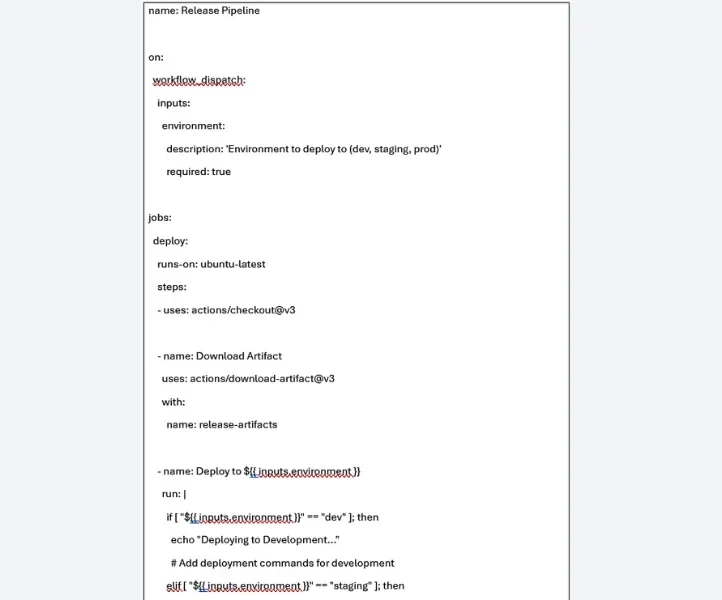
Home » CI/CD Pipelines with GitHub Actions and Azure DevOps for Full-Stack Applications

A crucial first step in automating and optimizing the software development process is establishing a Continuous Integration and Continuous Deployment (CI/CD) pipeline. We will go over best practices, integration techniques, and efficiency-boosting advice in this blog post as we walk through the process of building CI/CD pipelines for full-stack apps with Azure DevOps and GitHub Actions.
The foundation of DevOps is continuous integration and continuous delivery, or CI/CD. By attaining incremental software delivery, it facilitates rapid software development and deployment, allowing for continuous value delivery to end users. Applications can be built, packaged, and tested automatically with continuous integration, or CI. The CD pipeline receives these builds as inputs.
Applications are automatically delivered to specific infrastructure environments, such as development, UAT, and production, using continuous delivery, or CD. Any software can be deployed on any platform with Azure DevOps.
Software updates are delivered more quickly and reliably thanks to CI/CD pipelines, which automate the development, testing, and deployment of applications. They assist:
Cut down on human error.
Allow for ongoing feedback.
Make sure deployment procedures are consistent.
Establishing a strong CI/CD pipeline is essential for full-stack applications in order to preserve code quality and provide flawless user experiences.
Let’s look at how to use Azure DevOps Pipelines to automate build and deployment processes.
Go to https://dev.azure.com and log in to Azure DevOps as the first step. To store your projects, or repositories, you must at least establish an organization.
Kindly select values such as source control and visibility when creating an Azure DevOps project.
Setting up a series of automated procedures to build, test, and package your code is known as creating a build pipeline. This is a general guide to building a build pipeline that is specific to well-known tools like Jenkins, GitHub Actions, and Azure DevOps. For more specialized instructions, let me know if you’re using a particular tool or platform!
Select a CI/CD tool from GitLab CI/CD, Jenkins, GitHub Actions, Azure DevOps, and others.
Install the necessary build agents (cloud-hosted or self-hosted) and set up the environment.
Install the necessary dependencies for your tech stack, such as Python, Node.js, and the.NET SDK.
Store your code on a version control platform, such as Bitbucket, GitHub, or Azure Repos.
Make sure the repository is properly organized, with distinct folders for tests, source code, etc.
Add the necessary configuration files (such as Dockerfile,.gitignore, etc.) and a README.md.
When changes are pushed to a particular branch, the pipeline is triggered.
Build: Put the code together.
Test: Execute automated tests.
The package Make a deployable artifact, such as a container image,.zip, or.jar file.
Deploy (if desired): Either publish the artifact or move it to a staging, production, or testing environment.
Depending on the tool, this can be a GUI-based setup or a YAML configuration file.
Specify each stage’s steps. An illustration of a pipeline based on YAML:
YAML Pipeline Example for Azure DevOps:
The process of automating the deployment of your application to different environments (such as development, staging, and production) is known as a release pipeline. This is a general guide to release pipeline setup that can be customized for tools such as Jenkins, GitHub Actions, or Azure DevOps.
Development: Install in a test or development environment.
Staging: For validation, deploy to a pre-production environment.
Production: After validations and approvals, deploy to production.
Launch the application right away in the intended environment.
Rolling Deployment: To guarantee zero downtime, replace instances incrementally.
Blue/Green Deployment: To reduce risks, switch traffic between two environments.
Canary Deployment: Prior to a full rollout, deploy to a subset of users.
Verify the availability of the required infrastructure, such as servers and cloud environments.
For consistency, use infrastructure-as-code tools such as ARM templates, Terraform, or Bicep.
Among the possible artifacts are compiled binaries (.dll,.jar, etc.).
containers (like Docker images, for example).
scripts, such as those used for database migrations.
Sample Pipelines for Releases
Get free Consultation and let us know your project idea to turn into an amazing digital product.


A good way to automate the making, testing, and sending out of apps is to use an Azure CI/CD pipeline. Continuous deployment (CD) mixed with continuous integration (CI) helps you build nice software faster. Below is a list of the main parts and actions needed to set up and run an Azure CI/CD pipeline: Main parts of Azure Repos A place for source code to control versions.
Supported versions are Git and Team Foundation Version Control (TFVC).
Azure Pipelines
simplifies the steps of CI/CD for you.
allows YAML pipelines or traditional editors.
Create an agent
Run functions of the pipeline.
Azure gives you a hosted agent where the SDK and tools are pre-installed.
Self-Hosted Agents: Personalized agents that you control and are best suited for particular settings.
Artifacts from the Pipeline
files or packages (such as.zip,.jar, and container images) created during the build process for deployment.
Triggers
CI Triggers: initiate the process automatically the pipeline whenever a pull request is made or code is pushed.
CD Triggers: After a successful build, automatically add artifacts to environments.
The surroundings
Target deployment locations, such as development, staging, and production.
comprises rollback configurations and approval gates.
Library of Tasks
standardized tasks for routine operations (e.g., deploying apps, building code, and running scripts).
Gates of Release
Quality assurance is done in both automated and manual checks before proceeding to the next phase.
Purpose: Validate and package changes made to the code.
Steps:
Code Checkout: Fetching the source code from external repositories (such as GitHub or Azure Repos).
Project dependencies (like npm install and dotnet restore) are called restoring dependencies.
Build: Use a tool to build the application, for example mvn compile or dotnet build. Unit Tests: Run tests to verify that the changes made to the code work. Creation of Artifacts: Package the output of the build into a deployable format, such as.zip or.dll files. Artifact Publish: Upload the artifacts to Azure Pipelines so that they can be used in the CD process. YAML example for the CI stage:
Deploy verified artifacts to the intended environments.
Actions to take:
Release Triggers: Start deployment automatically when an artifact becomes available.
Environment-Related Activities:
For testing, deploy to development.
For user acceptance testing (UAT), deploy to staging.
After receiving approvals, deploy to production.
Tests and Validation:
testing for integration.
testing for smoke.
Approval Gates: Before deploying to sensitive environments (like production), manual approval is required.
Use tools such as Azure Functions, Kubernetes, or Azure App Services for deployment.
An example of CD Stage YAML
yaml Copy Edit :
Inside your repository, head over to .github/workflows/.
Generate a fresh file titled ci-cd-pipeline.yml.
unified cross-platform workflows.
improved deployment traceability.
freedom in selecting CI/CD tools.
How to Include
GitHub Actions to Start Azure DevOps Pipelines:
Databricks workflow integration into CI/CD pipelines is supported by both GitHub Actions and Azure DevOps:
Steps in Databricks CI/CD:
The Databricks CLI can be used to automate deployment.
Add scripts for deployment to your pipelines:
Example of Azure DevOps:
Split and organize your pipeline into deploy, test, and build phases. Use approval gates: Set up Azure DevOps approval gates for key environments. Track pipeline metrics: Monitor performance using GitHub Insights and Azure DevOps. Secure secrets: Store credentials securely using GitHub Secrets or Azure Key Vault.
Implementing continuous integration (CI) and continuous deployment (CD) for Node.js applications with Azure DevOps and GitHub Actions requires the integration of: Tools to efficiently build, test, and deploy your applications. Below are the step-by-step instructions:
Make sure the packages are valid in your application. JSON file with the required scripts:
{
“scripts”: {
“test”: “jest”, // Replace with your test runner
“build”: “webpack” // Replace with your build command
}
2. Add configuration files for testing or linting (e.g. .eslintrc.js, jest.config.js)
a. Start an Azure DevOps initiative: Create an Azure DevOps project. Link your Azure DevOps project to your GitHub repository.
Learn about Azure CI Pipelines for DevOps. Select Pipeline to create a new pipeline in Azure DevOps. Use the YAML pipeline editor to specify build and test steps. Example:
trigger:
branches:
include:
– main
pool:
vmImage: ‘ubuntu-latest’
steps:
– task: NodeTool@0
inputs:
versionSpec: ’16.x’ # Specify your Node.js version
displayName: ‘Install Node.js’
– script: npm install
displayName: ‘Install dependencies’
– script: npm test
displayName: ‘Run tests’
– script: npm run build
displayName: ‘Build application’
– task: PublishBuildArtifacts@1
inputs:
pathToPublish: ‘dist/’ # Path to build output
artifactName: ‘drop’
displayName: ‘Publish build artifacts’
Create a directory named .github/workflows/ in your GitHub repository.
Insert a file like ci.yml:
with Azure DevOps: a. Create a release schedule:
Create a release pipeline in Azure DevOps:
Insert steps for deploying your application e.g. Kubernetes, Azure App Service, Virtual Machines, etc.
Leverage published CI pipeline artifacts:
Use tasks such as Azure CLI and Azure App Service Deploy.
b. Link Azure DevOps releases to GitHub Actions
To initiate an Azure DevOps deployment, add a workflow to your GitHub repository:
Create a pull request or push changes to the main branch.
Verify that:
Your application is built and tested using a CI pipeline triggered by GitHub Actions.
If CI is successful, an Azure DevOps pipeline is triggered to deploy your application.
By using the Azure DevOps REST API together with GitHub Actions workflows, you can trigger an Azure DevOps pipeline from GitHub Actions for a full-stack project to kick off your project. Here are the detailed steps:
If you don’t already have a pipeline in Azure DevOps, create one for your project.
Enable Pipeline Trigger:
Go to Azure DevOps Pipeline Settings.
Enable CI Trigger if you want to start the pipeline when a branch is committed.
Alternatively, you can leverage the API or manual trigger.
In Azure DevOps, navigate to User Settings > Personal Access Tokens.
Create a new token with the scopes listed below:
Create (Read & Execute): This allows you to start a pipeline.
Optionally, you can add a project and team (read) for more complex situations. Store the generated token securely as you will need it in GitHub.
Access the repository on GitHub.
Navigate to Settings > Variables and Secrets > Actions.
Create a new secret:
Name: AZURE_DEVOPS_PAT.
Value: Your Azure DevOps PAT token.
Create a file named trigger-pipeline.yml in your GitHub repository.
To match your needs, adjust the workflow report’s on: section (e.g., branch, pull requests, guide dispatch).
the.github/workflows/trigger-pipeline.yml report in your repository and check the Integration Commit.
You can manually begin the workflow from the GitHub Actions tab or push adjustments to the configured branch.
Make positive the Azure DevOps pipeline is running properly.
Look for errors withinside the GitHub Actions workflow logs.
Verify that the Azure DevOps pipeline runs successfully.
Share your project idea with us. Together, we’ll transform your vision into an exceptional digital product!

You can create powerful CI/CD pipelines in your full-stack apps through utilising GitHub Actions and Azure DevOps. These systems provide the adaptability and sources wanted for easy build, deployment, and integration management.
A streamlined improvement procedure may be done through following this step-through-step manual to constructing CI/CD pipelines, irrespective of whether or not you’re operating on Databricks workflows, Azure-hosted apps, or different projects.
Add steps in your workflow to run tests using your preferred testing framework. For example, you can use npm test for Node.js applications.
Add tasks in your pipeline to run tests. Azure DevOps supports various testing frameworks and tools, such as NUnit, JUnit, and Selenium.
Define deployment steps in your workflow, such as building the frontend, deploying the backend, and configuring the environment. Use actions like actions/deploy to automate the process.
Use Azure Pipelines to define deployment stages, jobs, and tasks. You can deploy to various environments, such as Azure App Service, Kubernetes, or virtual machines.
Reusable workflows are predefined workflows that can be shared and reused across repositories. Reference them in your workflow YAML file using the uses keyword.
Pipeline templates are reusable YAML files that define common pipeline configurations. Include them in your pipeline using the template keyword.
Use the GitHub Actions UI to view workflow runs, logs, and statuses. You can also set up notifications for failed runs.
Use the Azure DevOps UI to view pipeline runs, logs, and statuses. Set up alerts and notifications for pipeline failures.
Yes, GitHub Actions supports multi-cloud deployments. You can deploy to AWS, Azure, Google Cloud, and other cloud providers using appropriate actions.
Yes, Azure DevOps supports multi-cloud deployments. You can deploy to various cloud providers using tasks and extensions.
Use variable groups and pipeline stages to manage environment-specific configurations. Define different stages for each environment.

In 2026, it’s vital for every developer to be skilled in using the right set of Azure developer tools for cloud projects. Microsoft’s Azure cloud platform is at the center of this shift, providing a wide range of solutions for building and managing apps. With cloud development with Azure, teams can launch reliable apps that scale globally and respond to business needs in real time. Picking the right items from the Azure tools list can save time, money, and help you get better results.

In 2026, moving workloads to Azure cloud migration is not just about transferring data. It’s about making the whole process smarter, more automatic, and easier to manage while keeping compliance and security tight.

The way small and medium-sized businesses (SMBs) operate has changed more in the past five years. Traditional systems that once felt reliable are now holding teams back. Data lives in silos, processes rely on too much manual work, and the cost of maintaining legacy servers keeps growing. So how do businesses modernize without disrupting what’s already working?

Founder and CEO

Chief Sales Officer
